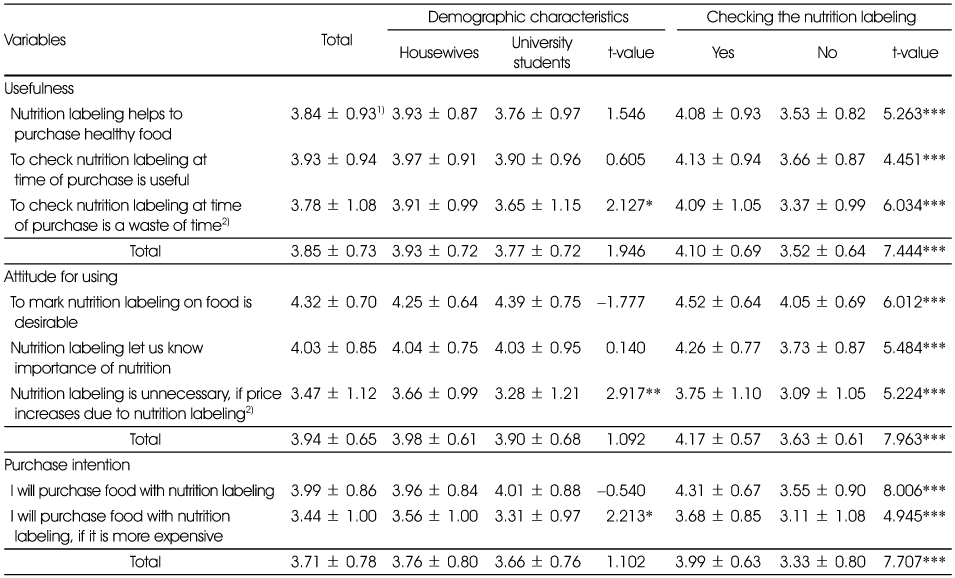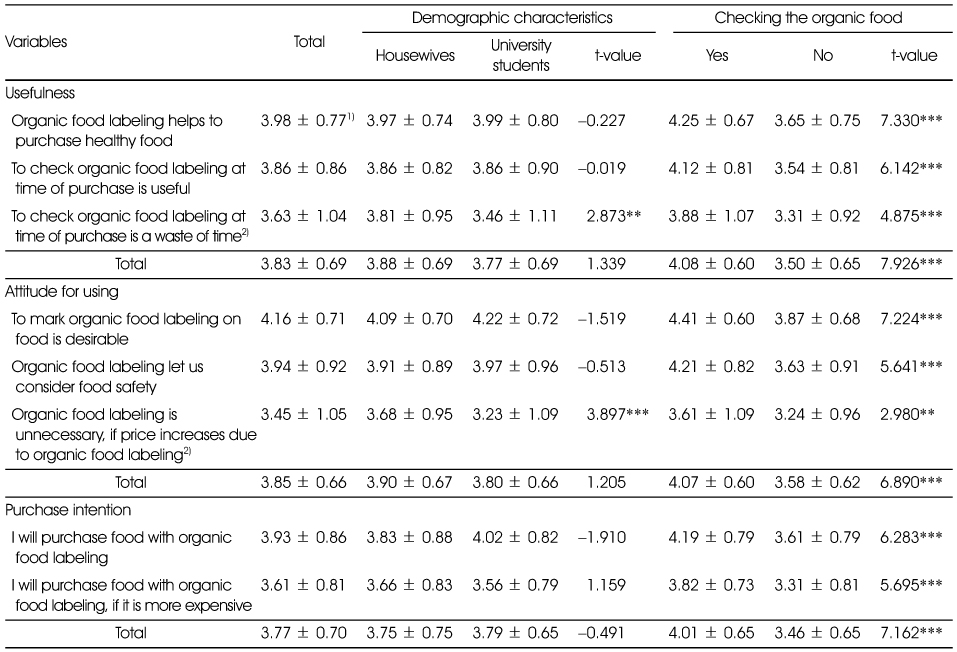References
1. An HK, Jin YH. Effect of the consumer recognition about food additives on the behavioral intention: Focused on the madiating effect of perceived risk. J Foodserv Manage 2009. 12(4)441–459.
2. Arvola A, Vassallo M, Dean M, Lampila P, Saba A, Lahteenmaki L, Shepherd R. Predicting intentions to purchase organic food: The role of affective and moral attitudes in the theory of planned behaviour. Appetite 2007. 50(2-3)443–454.
3. Bae KG. Current situation of agricultural organic products and organic processing food. Food Sci Ind 2006. 39(3)35–51.
4. Balasubramanian SK, Cole CA. Consumers' search and use of nutrition information: The challenge and promise of th nutrition labeling and education act. J Marketing 2002. 66112–127.
5. Borra S. Consumer perspectives on food labels. Am J Clin Nutr 2006. 83(5)1235S.
6. Burton S, Andrews JC. Age, product nutrition, and label format effects on consumer perceptions and product evaluations. J Consum Aff 1996. 30(1)68–89.
8. Chang NS. Food/nutrition attitudes views and practices of adults in Seoul area. Korean J Nutr 1997a. 30(3)360–369.
9. Chang SO. A study on the current nutrition labeling practices for the processed foods retailed in the supermarket in Korea. Korean J Nutr 1997b. 30(1)100–108.
10. Chang SO. A study of the comprehension and preference of consumers to four different formats of nutrition label. Korean J Nutr 1997c. 30(6)679–689.
11. Chen MF. Consumer attitudes and purchase intentions in relation to organic food in Taiwan: Moderating effects of food-related personality traits. Food Qual Prefer 2007. 18(7)1008–1021.
12. Choi JH, Chung YJ. Consumer preferred formats of nutrition labels. Korean J Community Nutr 2003. 8(2)220–230.
13. Chung EJ, Jeon JS, Ahn HS. Reading and understanding of food & nutrition labels and dietary behaviors of female middle and high school students. J Korean Diet Assoc 2010. 16(3)239–254.
14. Chung JY, Kim MJ. Using and understanding of nutrition labels and related factors among female adults in the Seoul area. Korean J Community Nutr 2007. 12(4)417–425.
15. Davis FD. A technology acceptance model for empirically testing new end-user information systems : Theory and results 1986. Sloan School of Management, Massachusetts Institute of Technology; Doctoral Dissertation.
16. Davis FD. Perceived usefulness, perceived ease of use, and user acceptance of information technology. MIS Quarterly 1989. 13(3)319–340.
17. Han MY, Ahn MS. A study on the purchase action of processed foods and the recognition for food additives of urban housewives. Korean J Diet Cult 1998. 13(2)119–126.
18. Hawkes C. Nutrition labels and health claims: The global regulatory environment. World Health Organization report 2004. Geneva:
19. Heijden HVD, Verhagen T, Creemers M. Understanding online purchase intention: Contributions from technology and trust perspectives. European J Information Systems 2003. 1241–48.
20. Hyun TS, Kim WS. A study on the perception and consumption of imported and organic produce of urban housewives. Korean J Community Nutr 1997. 2(1)74–85.
21. Jeon HR, Jae MK. Consumer consciousness toward wellbeing and well-being oriented consumer behaviors according to the dietary life: Focused on purchasing, using, and disposal behavior of married women. J Korean Living Sci Assoc 2007. 16(5)957–967.
22. Joo NM, Yoon JY, Kim OS, Ko YJ, Jung HA, Choi EY. A survey on the recognition and satisfaction of food labeling system in Seoul and Geongsangnam-do area. Korean J Food Cult 2005. 20(5)525–531.
23. Joo NM, Yoon JY, Kim OS, Park SH, Ko YJ, Kim JY. A study on the awareness of female consumers for nutrition labeling system. Korean J Food Cult 2006. 21(2)209–215.
24. Wills JM, Schmidt DB, Pillo-Blocka F, Cairns G. Exploring global consumer attitudes toward nutrition information on food labels. Nutr Rev 2009. 67(Suppl 1)S102–S106.
25. Jun SI. Problems in the delivery of food additives information and government strategies for them 2006. Korea Food & Drug Administration;
26. Kang JH, Jeong HG. Measuring the effects of belief, subjective norm, moral feeling and attitude on intention to consume organic beef. Korean J Food Cult 2008. 23(3)301–307.
27. Kim HC, Kim MR. Consumers' recognition and information need about food safety: Focused on pesticide residues, foodborne illness, and food additives. Korean J Diet Cult 2001. 16(4)296–309.
28. Kim HC, Kim MR. Consumer attitudes towards food additives. J East Asian Soc Diet Life 2005. 15(1)126–135.
29. Kim SY, Nayga RM, Capps O. Food label use, self-selectivity, and diet quality. J Consum Aff 2001. 35(2)246–363.
30. Klaus GG, Josephine MW. A review of European research on consumer response to nutrition information on food labels. J Public Health 2007. 15385–399.
31. Ko SY, Kim KW. Nutrition label use, self-efficacy, snacking and eating behavior of middle school students in Kyunggi area. Korean J Community Nutr 2010. 15(4)513–524.
32. Korea Centers for Disease Control and Prevention. The Fourth Korea National Health and Nutrition Examination Survey (KNHANES IV-1) 2008. 195–197.
35. Kreuter MW, Brennan LK, Sharff DP, Lukwago SN. Do nutrition label readers eat healthier diets? Behavioral correlates of adults' use of food labels. Am J Prev Med 1997. 13(4)277–283.
36. Kwon KI, Yoon SW, Kim SJ, Kang HN, Kim HN, Kim JY, Kim SY, Kim KL, Jung SM, Ock SW, Lee EJ, Kim JW, Kim MC, Park HK. A survey on customers' perceptions of nutrition labeling for processed food and restaurant meal. Korean J Nutr 2010. 43(2)181–188.
37. Lee HY, Kim MK. Dietary behavioral correlates of nutrition label use in Korean women. Korean J Nutr 2008. 41(8)839–850.
38. Lee IS, Choi BS, You DR, Park YM. College students characteristics and utilization of the nutrition labels on food package. Korean J Diet Cult 2002. 17(3)299–308.
39. Lee JS. Awareness on nutrition labeling of the processed food among elementary school teachers in Busan. Korean J Community Nutr 2009. 14(4)430–440.
40. Lee JW, Kim DS. Recognition of processed foods may affect the use of food labelings in middle school students. J Korean Diet Assoc 2003. 9(3)185–196.
41. Moorman C. The effects of stimulus and consumer characteristics on the utilization of nutrition information. J Consum Res 1990. 17(3)362–374.
42. Myung CO, Park YSm, Lee KW. A study on college students' awareness and life pattern on well-being. J East Asian Soc Diet Life 2007. 17(1)27–42.
43. Park SJ, You SY. A study of the effect of health motivation and environmental concern on choosing organic food. Consumption Cult Study 2007. 10(4)107–126.
44. Satia JA, Galanko JA, Neuhouser ML. Food nutrition label use is associated with demographic, behavioral, and psycosocial factors and dietary intake among African Americans in North Carolina. J Am Diet Assoc 2005. 105(3)392–402.
45. Sohn CH. Perception of nutrition labeling on restaurant menus among adults in Suwon. Korean J Community Nutr 2009. 14(4)420–429.
46. Suh BW. A study on the relationship between TV program related to health and diet and consumers' diet life. Korean J Food Mark Econ 2009. 25(2)29–48.
47. Wonnancott J. Food additives. Nutr Food Sci 1986. 86(1)20–21.
48. You SY, Park JH. An analysis of exploring the relationship between consumer concerns and changed behavior associated with the food safety and the influencing factors : Residue, microorganism, growth hormone, irradiation, food additives. Rev Bus Econ 2005. 18(6)2841–2858.
49. You SY, Park SJ, Yoon HY, Chinaxuefei . A study of influencing factors of behavioral intention for organic food. Industrial Economic Study 2008. 21(1)441–460.
50. Zarkin GA, Dean N, Nauskopf JA, Williams R. Potential health benefits of nutrition label changes. Am J Public Health 1993. 83(5)717–724.








